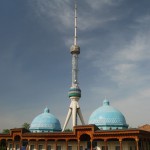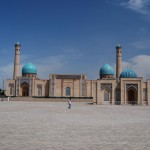Tashkent – capital of Uzbekistan Republic
It is difficult to describe in one article this most ancient city, yet it is more difficult to render its atmosphere and aura. Therefore, we will commit this task to the former journalist and local historian from Uzbekistan, who is now living in Israel, Slava Kim. This is his city, his hometown. There is probably no place in Uzbekistan, which his feet did not tread. Soon, a report will be posted about our joint journey through Uzbekistan, in which Slava Kim with his characteristic style and skillfulness will relate the history and culture of this country and, probably, will devote special place to his native city, Tashkent. Here is brief information about Tashkent for your attention.
Tashkent (in Uzbek – Toshkent) — is the capital of the Republic of Uzbekistan, the administrative center of the Tashkent province the largest by population city of Uzbekistan and of the entire Central Asia. Tashkent occupies the area of 300 sq. km.; its population is over 2.5 million people. Tashkent is the center of the Tashkent metropolitan area, the main airport, railway and car road hub as well as political, economical, cultural and scientific center of the country. Tashkent is administratively divided into 11 districts.
Tashkent is located in the north-east section of the republic, in the Chirchik River Valley, at the altitude of 440—480 meters above sea level. East and north-east of Tashkent there are the spurs of the West Tian Shan Mountains.
Tashkent is one of the most ancient cities. Its history is more than 2200 years long. It had different names in various historic periods, such as Yuni, Chach, Shash, and Binkath. The name Tashkent is mentioned for the first time in the 11th century, in the works of encyclopedic scholars Biruni and Mahmud Kashgari.
Tashkent translates as the city of stone or the stone city. The matter of the city name’s origin is still argued about. The most trustworthy is the following version: the city was located at the crossroads of the Great Silk Road; commerce and trades were well developed here, because of which the city thrived and was a much desired prize for many rulers, who tried to conquer it so many times. But the citizens had always put up desperate resistance. The city dwellers’ courage, endurance of character, their true grit are reflected in the city’s name.
Tashkent came into being in a densely populated valley on the border between settled and nomadic tribes as a trading center. Its favourable geographic location accelerated its development as a trading mediator city between the countries of the East and the West, and comfortable weather conditions created good opportunities here for the development of farming and cattle breeding.
In II-I BC, this region acquired the characteristics of an ancient city, fortified by a defensive wall. The city was a place of roaring trade, which is confirmed by discoveries of coins from near and far states – from Byzantium in the west to China in the east. In the I-IV centuries, it was a small independent state. In the Vth century it was captured by the Hephthalites, who created a huge state on the territory of the entire Central Asia, and in the VI century it was the Turks’ turn, and the city was included into the Turkic Kaganate. At that time the languages of the people who populated this region came under the influence of the Turkic language.
In the VIII century, Arabs came to the territory of the present Central Asia and brought Islam religion (which in Arab means “submission”) to this region, as well as their culture and architectural style. Upon the Arab’s coming, several constructions in the city sustained serious damage. Tashkent’s revival came only in the IX century.
IX-XII centuries were truly “golden” in the history of economic and, especially, cultural development of the region, which is called the period of Muslim Renaissance. It was the period of Kara-Khanid’s rule; the XIII century – the reign of Khorezmshah Muhammad. It was he, who ordered to destroy the irrigation systems in fear of the Mongol invaders; people left the city and the Tashkent oasis became desolate. This period is characterized with utmost ruin. Only in the XIV – beginning of XV centuries, the city which was then part of the state of Amir Timur, gained back its status of a strong fortress. Its territory was enlarged, trades, commerce and culture started to develop. The city was surrounded by a new wall. By the order of Amir Timur large architectural constructions were erected on the holy sites, some of them are still remaining to this day. After Timur’s death and during the reign of his grandson Ulugh Beg, feudal wars were waged and the state was in degradation for a long time. The XVIth century is noted for the coming forth of the Shaybanid dynasty, among its nomadic tribes there were those, who called themselves the Uzbeks, which means “one’s own masters.” Since that time the term Uzbek became common in use.
In the XVII-XIX centuries, Tashkent became the bone of contention between the Kokand Khanate and Bukhara Emirate. This period is not only characterized with multiple feuds inside the country but also with increasing interest for this large and rich region from the two great powers – Great Britain and Russia, who competed with each other for the right to exercise their influence in the region of Central Asia, and also for the market outlets and raw materials.
In 1865, after the second attempt to storm the city, it was captured by Russian troops. In 1867, the Tashkent Governorate General was formed with the capital in Tashkent.
When in October of 1917, power went to the coalition of Bolsheviks and left-wing Socialist revolutionaries, the city became the base of the Soviet power in the region. In 1918-1924 Tashkent was the capital of Turkestan ASSR. In April of 1924, VCIK RSFSR awarded “Tashkent’s proletariat” with the Order of Red Fighting Banner for the “service, rendered by the workers of the city of Tashkent as one of the centers of defense against the imperialistic assault.”
In 1930, the capital of the Uzbek Soviet Socialist Republic was transferred from Samarqand to Tashkent.
During the Great Patriotic War, Tashkent was one of the evacuation centers; plants, factories, theaters and movie studious moved here. Many people from the occupied territories of the European part of USSR lived in Tashkent in evacuation – for example, Anna Akhmatova, Faina Ranevskaya, Korney Chukovsky.
From 1930 till 1991, Tashkent was the capital of Uzbek SSR as part of USSR, and it was also the regional center of Tashkent region, the fourth largest city of the Soviet Union with the population of up to 2 million people. Starting from September of 1991, Tashkent is the capital of the independent Uzbekistan and center of the Tashkent Viloyat.
In 2009, Tashkent celebrated its 2200th anniversary.



